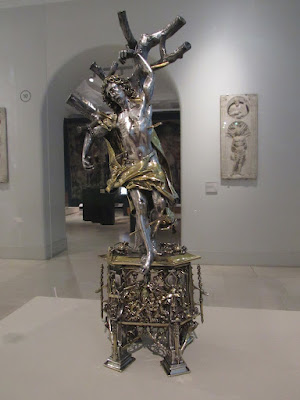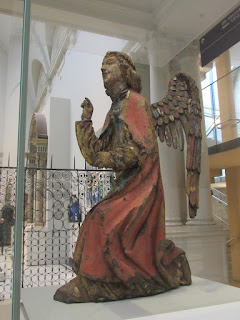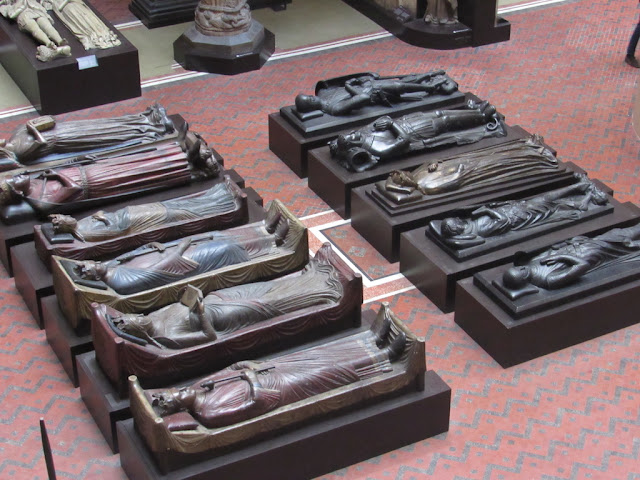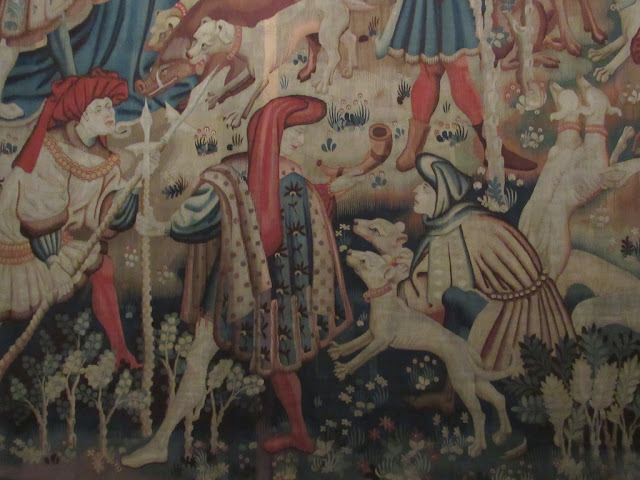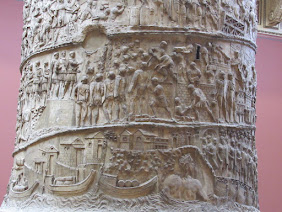Just walking into the Victoria and Albert Museum was an awesome experience. The rotunda and the Hereford Cathedral rood screen (see below) stood out. Even the guard who greeted me at the entrance enjoyed my astonishment. The museum was just down the road from my hotel and a quick bus ride away. While the British Museum is one of the great museums in Europe, I particularly like this one because it was less know and less crowded with people and it displayed some great works of art.
Established in 1852, the museum houses the world's largest museum of applied arts, decorative arts, and design, and a permanent collection of over 2.27 million objects including those from the Renaissance where I spent most of my time. It was named after the ruling Queen Victoria and her consort Prince Albert. Here are some of the objects that especially intrigued me with accompanying explanations from museum curators.
1497 St. Sebastian
St. Sebastian was believed to protect people from the plague. This powerfully expressive reliquary was a votive offering commissioned for a Cistercian monastery during an epidemic. Two relics bound in silk fabric are visible behind a glass window. They may be fragments of wood, perhaps thought to be shards of the arrows that pierced the saint.
Partially gilded silver, set with glass, pearls, sapphires and rubies.
About 1500 This reliquary bust has inscriptions on the front and base that indicate it once contained the relic of the head of Antigius, a mysterious saint and legendary bishop of Brescia (in Lombardy, Italy). It was commissioned by the monastery of St. Faustino and St. Giovito in Brescia where the relics had been stored since the 9th century.
1430-40 Death of the Virgin Christ is shown with his hand raised in blessing his mother. He has returned to transport his mother's soul and body to Heaven upon her death. Some of the apostles are reading prayers, as was recommended around every death bed. On the far right, one apostle holds a censer so another can pour incense into it from an incense boat.
About 1415-50 The Angel Gabriel from the Annunciation
This rare wood sculpture from 15th century France was probably part of an altarpiece. The angel is telling the Virgin Mary that she is about to bear the Son of God. The Annunciation was familiar to all Christians, though Gabriel usually approaches from the left.
1499-1505 Effigy of Don García de Osorio and wife
Don García, a knight of the Order of Santiago, was buried in the church of San Pedro in Toledo, Spain. Though he wears chain mail and armor, his helmet has been removed and placed at his feet with a symbolic figure of mourning (below). His wife's effigy next to him has a similar figure at her feet.
1499-1505 Effigy of Doña María de Perea Doña María holds rosary beads as a sign of her piety. This piety is also symbolized by the books at her feet. Her sober, modest dress is nonetheless expensive, as suggested by the delicate embroidery edging her undergarment. Don García, her husband is shown nearby, and both effigies may originally have been painted.

1425-50 Lector's Tombstone. Its spiral columns, elaborate Gothic arch and arrangement of books beneath the figure, is similar to ones in Bologna. The books' cowl and shoulder cape indicate the man was a lector at the University of Bologna. Lectors were often honored with such tombs.
About 1307 Effigy of an unknown knight
This effigy lies as if asleep on his sarcophagus. It was originally mounted high on a wall in the church, tilted at an angle to make it more visible.

Etching of a Medieval Knight in bronze.
About 1565 The Rape of Proserpina
This dramatic sculpture shows Pluto, King of the Underworld, carrying off Proserpina with whom he had fallen in love. It originally belonged to Giovan Vettorio Soderini, a leading exponent of garden design in 16th century Florence who promoted the use of sculpture and fountains. Soderini described water as "the soul of cities and gardens". In 1594, the bronze group was sold to Antonio Salviati, who placed it on an elaborate fountain in his palace garden.
About 1480 This popular type of sculpture, known as a "Palmesel" or "Palm Donkey", represented Christ during religious services around Easter. On Palm Sunday, it was drawn through the streets to commemorate his triumphal entry into Jerusalem.
This is the second time I've seen this sculpture. Its realistic representation is astounding.
The Nativity

Ambo for reading the Scriptures A pretty cocky rooster
1300-50 St. Michael in walnut painted and gilded. Wings and spear missing
The
Archangel Michael is shown overcoming Satan in the form of a dragon.
During the 14th century the cult of St. Michael became widespread, but
it was particularly cherished in France by the Valois dynasty. A
sculpture like this might have stood in a church aisle or in a chapel
dedicated to St. Michael.
About 1480-90 St. George and the Dragon
St. George was a saint from the East, but as a result of the Crusades he became popular throughout Europe. Having rescued a princess by slaying a dragon, he personified the ideals of chivalry and was often depicted with the tamed or dead beast beside him.
About 1530-40 St. Margaret and the Dragon. Pregnant women called upon her to protect them in childbirth because of her miraculous escape from the belly of a dragon.
1500-30 Tomb Effigy of a Woman
This woman may have been a wealthy widow who joined a religious order after her husband's death. She wears a loose habit, probably similar to her burial clothes. The wrinkles around her eyes suggest her age. Full-length effigies of women holding books were popular in Naples, where the relief probably originated.
1430, moved and repaired 1536 Monument of Marchese Spinetta Malaspina
Spinetta Malaspina was a condottiere (military commander) who died in 1407. Later, his heirs placed this memorial in the church of San Giovanni in Sacco, Italy, that Spinetta founded outside the city. Its equestrian form is typical of Verona. Originally, the sculp-ture was probably brightly painted and gilded. The sarcopha-gus behind the row of figures is merely symbolic, indicating that the monument should be read as a cenotaph--a memorial with no body.
1430-50 Devonshire Hunting Tapestry
Tapestry is one of the oldest forms of woven textiles. For centuries these beautiful objects were among the most magnificent possessions of kings, princes, and popes. The Devonshire Hunting Tapestry was probably made in Arras, in modern day France, a center famed for supplying the courts of France and Burgundy with magnificent wall hangings.
Tapestries were expensive and much-prized during the medieval and Renaissance periods. They were easy to transport and well-suited to the traveling lifestyle of the northern courts up to the 17th century, which provided a means for insulating and decorating the coldest and gloomiest castle. Tapestries would have hung from floor to ceiling and been placed edge to edge, like wallpaper in a modern room. Those with narratives also provided entertainment and interest for the household and guests at a time of low literacy, when images were extremely important.
The hunt was a particularly powerful theme and would have been a familiar pastime as well as an important source of food to many of the high-born individuals and families who owned tapestries. Henry VIII was known to have owned over 200 tapestries illustrating hawking and hunting scenes.
This tapestry also features a number of elegant couples. In the center of the tapestry a lady wears a sumptuous blue gown decorated with back-to-front letters that spell the motto "much desire". The man's sleeve is decorated with silver shapes that resemble teardrops and probably also relate to the pursuit of love.
The rich red gown of the lady is lined with miniver, an expensive fur obtained from the bellies of Baltic squirrels. A lining on this scale would have required hundreds of skins, taken from squirrels killed during the winter months.
Replica of Trajan's Column

In back-to-back wars fought between A.D. 101 and 106, the emperor Trajan
mustered tens of thousands of Roman troops, crossed the Danube River on
two of the longest bridges the ancient world had ever seen, defeated a
mighty barbarian empire on its mountainous home turf twice, then
systematically wiped it from the face of Europe.
Trajan’s war on the Dacians, a civilization in what is now Romania, was the defining event of his 19-year rule. The loot he brought back was staggering....The booty changed the landscape of Rome. To commemorate the victory, Trajan commissioned a forum that included a spacious plaza surrounded by colonnades, two libraries, a grand civic space known as the Basilica Ulpia, and possibly even a temple. The forum was “unique under the heavens,” one early historian enthused, “beggaring description and never again to be imitated by mortal men.”
Towering over it was a stone column 126 feet high, crowned with a bronze statue of the conqueror. Spiraling around the column like a modern-day comic strip is a narrative of the Dacian campaigns: Thousands of intricately carved Romans and Dacians march, build, fight, sail, sneak, negotiate, plead, and perish in 155 scenes. Completed in 113, the column has stood for more than 1,900 years.
by Andrew Curry of National Geographic, September 2012
About 1760-64 Joshua Ward was a renowned philanthropist who founded several hospitals for the poor. Known at the time as a "quack doctor", he was not medically trained but made his fortune by concocting popular patent medicines. This marble figure may have been intended for a planned monument in Westminster Abbey, which was never built. His hand gesture indicates generosity, while his bulky figure suggests prosperity.
1809-48 This marble monument and poem were dedicated to the sacred memory of Emily Georgiana, the beloved wife of George William, Earl of Winchilsea and Nottingham who died July 10, 1848 and was buried in the chancel of Ewerby Church in Lincolnshire. She was 39 years old. Lawrence Macdonald (1799-1879) was a Scottish sculptor who worked mainly in Rome and specialized in portraits for a British clientele. This memorial shows Lady Winchilsea in an elegant classic pose inspired by Canova's famous portrait of Pauline Bonaparte, also reclining on a daybed. The inscription evokes the sadness of her early death.
Here is the poem inscribed on the sides of the monument. A reclining figure reading a book was a common pose for tombstones at the time.
This rood screen was a star piece
in the International Exhibition of 1862, held in London, before its
installation in the Cathedral in 1863. A contemporary described it as
"one of the most important works, not only for its size but for the care
with which it had been executed, and the successful endeavor to treat
what is in fact a large architectural subject in metal alone." In its
profusion of ornament and color, the screen is one of the finest
examples of the Gothic Revival style. It took just five months to make. It is one of the monuments of High Victorian art, a masterpiece in the Gothic Revival style.
The 1862 exhibition was intended to stimulate trade as well as to have popular appeal. Good design was a major consideration. The exhibition included every important type and process of contemporary manufacture.
The
screen is 10.5 meters high, 11 meters long and weighs over 8 tons. Its
basic structure of timber and cast iron is embellished with wrought iron,
burnished brass, and copper. Much of the copper and ironwork is painted
in a wide range of colors. The arches and columns are decorated with
polished quartz and panels of mosaic.
A screen was essential to a medieval cathedral, as the barrier which separated nave from choir, congregation from clergy. By the 19th century, most had disappeared. Sir George Gilbert Scott began to reinstate this medieval feature. Noted especially for building new churches, Scott began to restore old churches in the 1860s. He aimed to reintroduce a sense of architectural and spatial cohesion, and boldly added modern work to achieve this aim. His most impressive screens were largely of iron, as at the cathedrals of Lichfield (1861), Hereford (1862), and Salisbury (1869-72), and all were constructed by Skidmore of Coventry. No medieval screens were made of iron--then far too costly--but always of stone or wood. Scott regarded iron as an important "modern" material and used it extensively, both structurally and decoratively.
Celebrated in the 19th century, the screen fell from favor in the 20th century. Aesthetically, it was seen as ugly and incongruous in a medieval building. Liturgically, it was held to form an unacceptable barrier.

Queen Victoria's sapphire and diamond coronet
(left). After Albert's death in 1861, Queen Victoria was grief-stricken
and for years could not face the public ordeal of the ceremonial
Opening of Parliament. But on February 6, 1866, she came in from Windsor
for the event "terribly nervous and agitated". For the opening she wore
"a small diamond and sapphire coronet, rather at the back". For this
special occasion, and in this later portrait by Graves, Queen Victoria
chose to wear the coronet that Albert had designed for her. It remains
an enduring symbol of their love--and one of the prized treasures of the museum.

Prince Albert designed this coronet (right) for his wife, Queen Victoria. It is one of the most important jewels worn by the young queen. Albert took a keen interest in his wife's jewellery. On February 22, 1843, Victoria recorded in her journal: "We were very busy looking over various pieces of old jewelry of mine., settling to have some reset....Albert has such taste, and arranges every for me about my jewels". The coronet is articulated so Victoria could wear it either as a closed circle or opened out at the back.
And finally...
A memorial plaque for museum workers who lost their lives in World War I.
I happened to be at the museum on November 11 just before 11 a.m. The museum announced a 2-minute moment of silence in memory of the war's victims. Being in London, England, at this time and paying my respects to the fallen made the war more real, more impactful.
Resources
Victoria and Albert Museum curators -- https://www.vam.ac.uk
https://www.vam.ac.uk/collections/tapestry
Trajan's column -- "A War Diary Soars Over Rome" https://www.nationalgeographic.com/trajan-column/article.html




